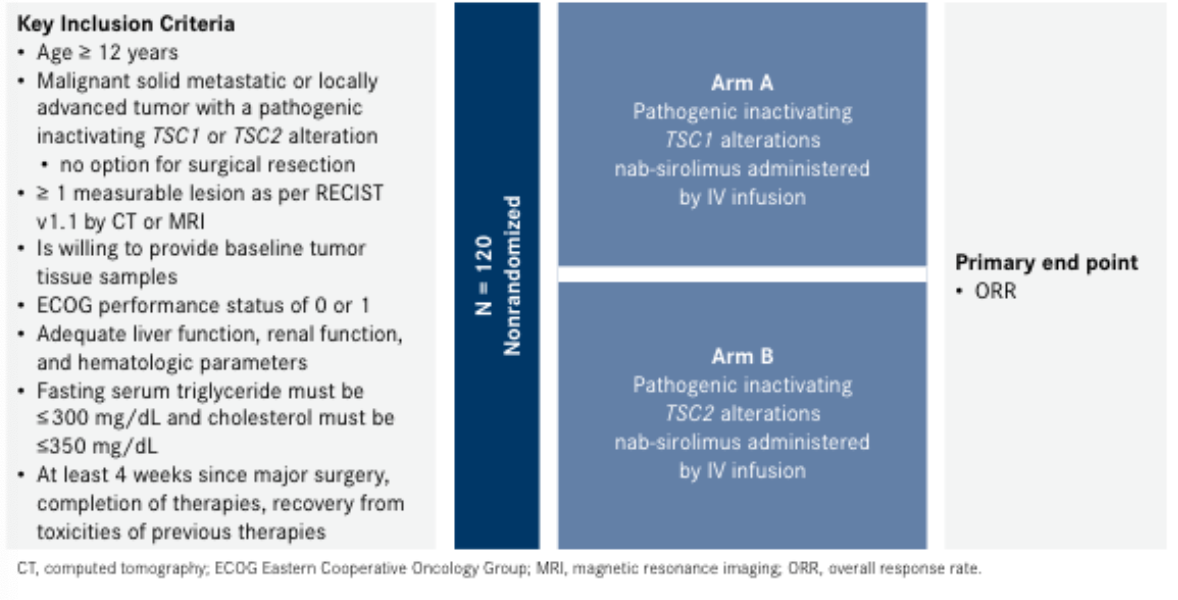Basket Trial Investigates Nab-Sirolimus for Treatment of TSC1/2 Mutations
With no approved agents for patients with malignant tumors harboring TSC1 or TSC2 inactivating alterations, investigators seek to establish a new pathway forward for patients with solid tumors in the PRECISION 1 trial.
Brian Schulte, MD

Targeting TSC1/2 gene mutations with the (albumin-bound) mTOR inhibitor nab-sirolimus (ABI-009) is a promising treatment for rare subtypes of sarcoma, emerging in a field with few options for patients with advanced disease. With no approved agents for patients with malignant tumors harboring TSC1 or TSC2 inactivating alterations, investigators seek to establish a new pathway forward for patients with solid tumors in the PRECISION 1 trial (NCT05103358).1
“TSC1 and TSC2 are pathogenic mutations that we see in a large variety of different histologies, histologic subtypes, [and] different malignancies, and the prevalence varies depending on that type of cancer,” Brian Schulte, MD, said in an interview with OncologyLive®. “These alterations are tumor suppressor genes upstream in the mTOR pathway. Alterations or deletions in these genes may lead to mTOR overactivation, which prompts uncontrolled cell growth, metabolism, and survival.” Schulte is an assistant professor of medicine at the University of California, San Francisco.
The most common alterations in TSC1 are TSC1 mutation (1.69%), TSC1 loss (0.07%), TSC1 R1097C (0.03%), TSC1 amplification (0.03%), and TSC1 R228Q (0.02%). Among all cancer, TSC1 is altered in 2.15% of cancers.2 For TSC2, the most common alterations include TSC2 mutation (2.81%), TSC2 amplification (0.13%), TSC2 loss (0.10%), TSC2 fusion (0.18%), and TSC2 F1510del (1.14%), with alterations present in 3.39% of all cancers.3
Alterations have been documented in bladder, breast, colon, uterine, lung, skin, ovarian, prostate, and pancreatic cancers, among others.2,3 Focusing on the mechanism of mTOR inhibition, investigators have demonstrated efficacy with the agent nab-sirolimus (Fyarro). Data from the phase 2 AMPECT trial (NCT02494570) demonstrated durable responses in patients (n = 31) with perivascular epithelioid cell neoplasms (PEComas) who received nab-sirolimus.4,5
“We know from studies [such as] AMPECT that targeting TSC1 and TSC2 or, in particular, the mTOR pathway, leads to a high response rate and a durable response for those patients,” Schulte said. The study met the primary end point with patients achieving an overall response rate (ORR) of 39% (95% CI, 22%-58%). In the final analysis, 2 complete and 10 partial responses were reported, and the median duration of response was not met, with half of responders having a response lasting at least 36 months.6
The median overall survival was 40.8 months (95% CI, 22.2 months-not reached) and 89% of patients with a TSC2 mutation experienced a confirmed ORR (P < .001). The treatment was approved by the FDA in November 2021 (Table).4,5
Table. Approval Snapshot: Nab-sirolimus

“[In data from an] expanded access program that was done as part of the AMPECT trial, we did see a relatively high response rate; this was in a small group of patients, but, nonetheless, a group of heterogeneous histologies that had been failed by an excess of 3 lines of treatment beforehand, and over 50% of these patients had responded,” Schulte said. “This is a select group of patients, but…I would say that what we found necessitated further study. Our hope is that we’re going to be able to benefit a large group of patients by offering this therapy, but it is vital that we [seek to] answer this question further.”
Seeking Out Inactivating Alterations
A mutational analysis conducted in the AMPECT trial also shined a light on the potential for association of efficacy with TSC1 and TSC2 mutations. Among patients with a TSC2 mutation (n = 9), the ORR was 89%, with responses also being reported among patients with TSC1 mutations.6
“The TSC1 and TSC2 genes are tumor suppressors by their very nature,” Schulte said. “Their purpose is to abrogate proteins that are downstream, such as mTOR, which is the pathway they exist in. The thought is that by their mutation, [that] they’re not functioning anymore, those lead to further tumor growth through an alternate pathway."
Available mTOR inhibitors including sirolimus (Rapamune) has variable absorption and often requires therapeutic drug monitoring, according to Schulte. Nab-sirolimus, a nanoparticle albumin–bound sirolimus construction, is an intravenously (IV) administered mTOR inhibitor with significantly higher tumor growth inhibition, higher intratumoral drug accumulation, and greater mTOR target suppression.5
“Sirolimus is a well-established medication; it’s commonly used among our patients and other patients ... for immunosuppression,” Schulte explained. “In vitro and in vivo studies that were done with this formulation, the albumin-bound sirolimus, suggested that there were favorable pharmacokinetic and pharmacodynamic properties. This ultimately led to the impetus for AMPECT.”
Expanding Efficacy With PRECISION 1
PRECISON 1 will follow the same administration cycle of nab-sirolimus, with investigators seeking to enroll patients with TSC1 or TSC2 inactivating alterations, which are required to be centrally confirmed by next-generation sequencing (NGS) and not liquid biopsy alone.1 Patients will be randomized into 2 arms; arm A will be the patients with inactivating TSC1 alteration, and arm B will be those with inactivated TSC2 alterations. Additionally, patients must provide baseline tumor samples, be ineligible for surgical resection, have at least 1 or more measurable target lesion, and meet criteria for adequate liver, renal, and hematologic parameters.1
The primary end point is overall response (Figure).1 Secondary outcomes include duration of response, disease control rate, time to response, and progression-free and overall survival. Further, patients must have received all standard therapies deemed appropriate for their tumor type and stage of disease and for whom other available options would not be clinically beneficial. “[It is] vital to understand that these patients [must have] failed accepted therapies for their solid tumors prior to enrolling,” Schulte said.
Figure. PRECISION 1 Phase 2 Multi-institutional Basket Trial Design

Mark Agulnik, MD, who is section chief of sarcoma medical oncology and a professor in the Department of Medical Oncology and Therapeutics Research at City of Hope in Duarte, California, noted that the stratification of patients based on TSC1 and TSC2 alterations will hopefully add to the pool of knowledge regarding the prognostic value of the mutations. “We'll be able to dissect a lot of information about the patients coming into the trial and have a better understanding of what is the true role of TSC1 and TSC2 mutations, and if we are able to affect outcomes by inhibiting these inactivating alterations. When we’re looking at numbers [of patients in prior studies], that there were approximately 31 patients evaluable, [and] if we are looking at numbers less than 35, it becomes very hard to make conclusions,” he said in an interview with OncologyLive®. “I’m anticipating that with 60 patients in each arm [in PRECISON 1] that we will be able to finally make a conclusion [on TSC1/2 inactivating alterations] after the 120 patients are enrolled.”
Among the eligible patients anticipated to enroll in the tumor-agnostic study, Agulnik said that he expects to see patients referred from genitourinary and gastrointestinal oncologists. “There certainly should be patients with bladder and kidney [cancers, as well as] colon, stomach, and esophagus cancers, but it is open to patients with melanoma and lung cancer, with the [alterations as] the guiding malignancies. The barrier to enrollment is going to be the same barrier we see when we’re trying to enroll any tissue-agnostic trial. It’s a matter of competing trials that individuals will have [access to].”
Agulnik noted that with respect to tumor-agnostic trials, it is important that clinicians are aware that these studies are available when reviewing NGS reports. “These are very rare mutations,” he said, noting that there is precedence in other rare mutational trials that have been able to meet the enrollment criteria. “It will take a little bit of time, and it takes a little bit of work. What’s nice is it is a phase 2 clinical trial, and we know the anticipated adverse events, [making it so] we can counsel our patients accordingly. There are no dose adjustments, [with all patients being] given the FDA-approved standard dose. That in itself also allows for patients to have a better understanding of their expected [toxicity].”
Schulte added that reported experiences with the administration [and] the toxicity profile of nab-sirolimus were comparable to those observed with other mTOR inhibitors. “We see things such as mucositis, fatigue, anemia, [and] some metabolic abnormalities, but it’s important to understand that although these occur, there weren’t any grade 4/5 adverse events on the AMPECT study,” Schulte said. “We would expect to see similar adverse [events] in [PRECISION 1].”
“It’s important that we answer this question, [and] it’s amazing to have the opportunity to study this medication and to apply it to a population of patients who may not necessarily have many options,” Schulte said. The first patient in the trial was dosed in March 2022.7
The trial is open for enrollment.
References
- Phase 2 basket trial of nab-sirolimus in patients with malignant solid tumors with pathogenic alterations in TSC1 or TSC2 genes (PRECISION 1). ClinicalTrials.gov. Updated October 12, 2022. Accessed October 20, 2022. https://clinicaltrials.gov/ct2/show/NCT05103358
- TSC1. My Cancer Genome. Accessed October 31, 2022. https://www.mycancergenome.org/content/gene/tsc1/
- TSC2. My Cancer Genome. Accessed October 31, 2022. https://www.mycancergenome.org/content/gene/tsc2/
- FDA approves sirolimus protein-bound particles for malignant perivascular epithelioid cell tumor. FDA. Updated November 23, 2021. Accessed October 31, 2022. bit.ly/3JtAoG4
- Fyarro. Prescribing information. Aadi Biosciences Inc; 2021. Accessed October 31, 2022. bit.ly/3GS6Lwb
- Wagner A, Ravi V, Riedel RF, et al. Final analysis from AMPECT, an open-label phase 2 registration trial of nab-sirolimus for patients with advanced malignant perivascular epithelioid cell tumors (PEComa). Abstract presented at: 2021 Connective Tissue Oncology Society, November 10-13, 2021.
- Aadi Bioscience announces first patient dosed in its PRECISION 1 phase 2 registrational trial of nab-sirolimus in patients with solid tumors harboring pathogenic inactivating alterations in TSC1 and TSC2 genes. News release. Aadi Bioscience Inc. March 31, 2022. Accessed October 31, 2022. bit.ly/3FIXMR9




